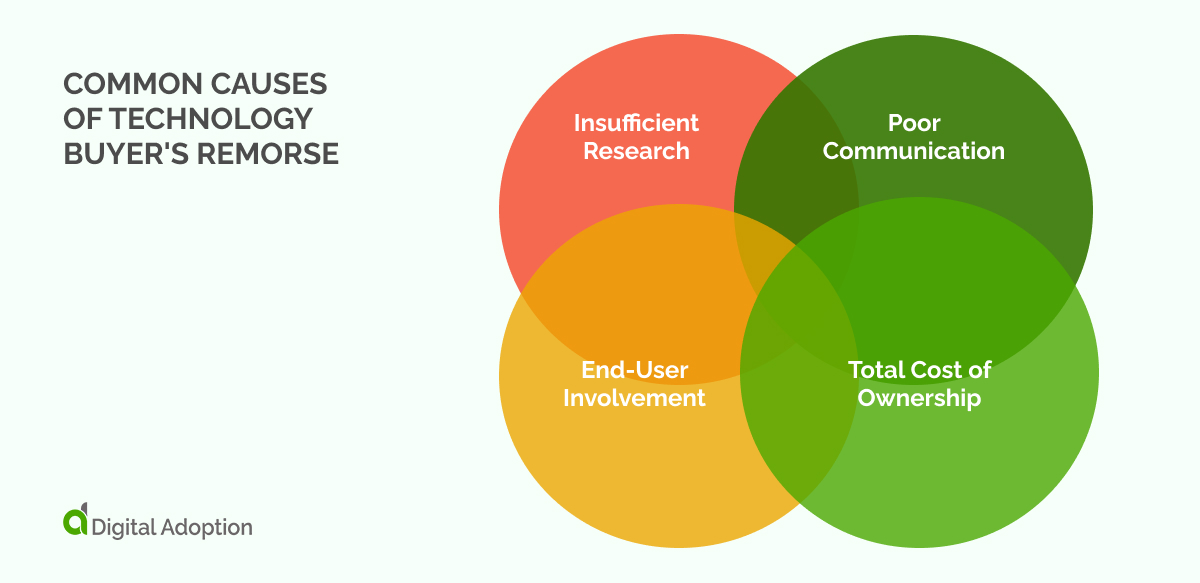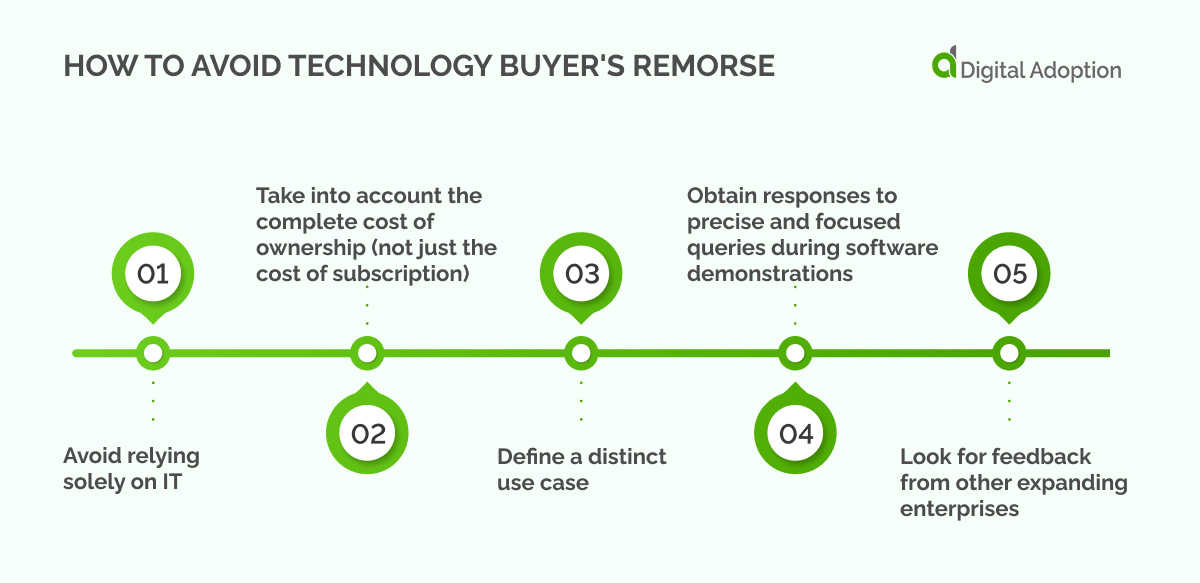Technology has transformed how businesses operate, allowing them to increase IT efficiency, boost revenue, and capture larger market shares.
However, with all the benefits technology brings, there are potential pitfalls, one of which is technology buyer’s remorse. According to a Gartner survey, 60% of technology buyers involved in renewal decisions regret nearly every purchase they make.
This regret can be costly in terms of time and money and hinder business growth.
Technology buyer’s remorse can be a common experience when adopting and investing in new digital technologies. With the fast pace of innovation, consumers are constantly bombarded with new and improved products that promise to make their lives easier. Yet, the excitement of owning the latest gadget can quickly turn into regret when buyers realize they don’t need or use all of the features.
This can lead to a reluctance to adopt new technologies in the future, as consumers become wary of investing money and time into something that may not be worthwhile. As a result, companies need to develop innovative products and educate consumers on how to effectively integrate them into their lives to prevent technology buyer’s remorse and promote digital adoption.
Thankfully, there are steps that business owners can take to avoid buyer’s remorse when investing in technology. This article will explore the top five tips for making smart technology buying decisions that drive productivity, boost revenue, and navigate tech procurement without buyer’s remorse.
So, if you want to invest in the right technology for your business, read on to discover how to avoid buyer’s remorse.
What Is Technology Buyers Remorse?
Technology buyer’s remorse is a term used to describe the regret or disappointment that business users can experience after investing in a new technology product or service. Business users, such as managers, CIOs, or executives, often make large investments in technology solutions in the hopes of improving employee productivity and increasing profitability. When these solutions fail to meet expectations, it can lead to frustration and a sense of wasted resources.
This can happen for various reasons, such as inadequate research before purchasing, overhyped marketing claims, or poor implementation and support. In addition to negative impacts on the business’s bottom line, it can also lead to a loss of employee morale and trust in leadership.
According to the 2023 Forbes SMB Tech Trends Survey, 61% of SMBs in the US have experienced buyer’s remorse over a technology purchase they made in the past year.
To avoid technology buyer’s remorse, businesses should conduct thorough research, evaluate their needs and goals, and consider the long-term implications of the investment. Working with reputable vendors who provide excellent customer support and have a proven track record of success is essential.
Common Causes of Technology Buyer’s Remorse

Technology buyer’s remorse is often caused by a variety of factors. Here are some of the most common causes of technology buyer’s remorse:
Insufficient Research
One of the leading causes of technology buyer’s remorse is insufficient research. Companies may rush into a purchase without fully understanding the capabilities and limitations of the technology.
They may also fail to consider how the technology aligns with their long-term goals, which can result in the technology becoming obsolete or outdated quickly. Companies should thoroughly research potential solutions to avoid buyer’s remorse and ensure they align with their organizational goals and objectives.
Poor Communication
Another major cause of technology buyer’s remorse is poor communication between the company and the technology vendor. Misunderstandings and miscommunications can create unrealistic expectations, leading to disappointment when the technology fails to deliver as promised.
To avoid this, companies should communicate clearly with vendors and ensure that expectations are set early. Additionally, companies should work to build strong relationships with vendors to foster open and honest communication throughout the technology implementation process.
Total Cost of Ownership
The total ownership cost is another factor contributing to buyer’s remorse. While a particular solution may seem affordable upfront, ongoing maintenance, upgrades, and training costs can quickly add up.
Companies must consider the total cost of ownership before investing in new technology. This includes not just the financial costs but also the time and resources required to implement and maintain the technology.
End-User Involvement
Lastly, companies may experience buyer’s remorse when they fail to involve end-users in decision-making. Employees not consulted or trained properly may resist the new technology, leading to low adoption rates and wasted resources.
In order to prevent issues, it is recommended that companies engage with end-users throughout the process of selecting and implementing technology. This involves soliciting employee feedback and input, offering training and assistance, and ensuring that the technology is compatible with the needs and procedures of end users.
How to Avoid Technology Buyer’s Remorse

When it comes to technology purchases, businesses can often experience buyer’s remorse if not done correctly, leading to a waste of resources and dissatisfaction among employees.
To avoid this situation, we have compiled a list of five tips for businesses to consider:
Avoid relying solely on IT
Technology buyers remorse is a common issue businesses face after purchasing new software or hardware. One way to avoid this is by avoiding relying solely on IT for making technology purchases. While IT plays an important role in the decision-making process, getting input from other departments is also important.
Departments like marketing, sales, customer service, and finance may have specific needs that IT may not be aware of. So, involving these departments in the decision-making process can help businesses avoid technology buyers remorse.
Businesses can ensure that the purchased technology helps improve the overall business operations and meets the specific requirements of different departments. This can lead to higher employee satisfaction levels and better ROI for the business. In addition, involving other departments also helps create a sense of inclusivity across the organization and promotes collaboration.
Take into account the complete cost of ownership (not just the cost of subscription)
Businesses often make the mistake of only considering the subscription price of a technology solution while making a purchase decision. However, the total cost of ownership includes several other factors, such as implementation costs, maintenance costs, training costs, and more. If businesses fail to consider these factors, they might end up with a solution that is not feasible in the long run, leading to technology buyers remorse.
Therefore, it is essential to consider the complete cost of ownership while making technology purchases. Businesses can better understand the expenses of implementing and maintaining the solution in the long run. This helps make a more informed purchase decision and avoid surprises. Additionally, considering the complete ownership cost helps create a realistic budget for the technology purchase.
Define a distinct use case
One of the most common causes of technology buyers remorse for businesses is a lack of a distinct use case for the purchased technology. Before making any technology purchases, it is essential to define a clear use case that outlines the specific requirements and benefits of the technology. This helps align the technology with the business goals and ensures that the purchased solution meets the business’s specific needs.
Businesses can also better understand the transformation ROI by defining a specific use case for the technology. Additionally, it helps avoid unnecessary expenses due to purchasing technology that does not align with the business goals.
Obtain responses to precise and focused queries during software demonstrations
Software demonstrations are an important part of the technology purchase process. They allow businesses to see the software solution in action and gauge its effectiveness. However, asking precise, focused questions during the demonstration is important to better understand the solution’s capabilities.
By asking precise and focused questions during software demonstrations, businesses can avoid false expectations of the solution’s capabilities and ensure that the purchased technology meets the business’s specific needs. This can help reduce the chances of technology buyers remorse and improve overall employee satisfaction levels.
Look for feedback from other expanding enterprises
Another effective way to avoid technology buyers remorse is by seeking out feedback from other growing businesses. This can help businesses gain valuable insights into the effectiveness of different technology solutions and their implementation. Businesses can learn from the experiences of other organizations and make informed decisions about technology purchases.
Seeking feedback from other expanding enterprises also helps identify any potential issues that may arise during the implementation and maintenance of the solution. This can help create a more comprehensive plan for implementing the solution and ensure the purchased technology is feasible in the long run.
Navigating Modern Business Without Buyers Remorse
Navigating modern business without buyer’s remorse can be challenging, but it is not impossible. The key to avoiding buyer’s remorse is researching and making informed decisions backed by decision support systems (DSS). Take your time to evaluate all the options available to you, consider the pros and cons of each, and make sure that you are getting the best value for your money.
It is also important to communicate with your suppliers and vendors and to build strong relationships based on trust and transparency. This means being upfront about your needs and expectations and asking questions when unsure.
Remember that mistakes happen; it is okay to admit when a wrong purchase decision has been made. The most important thing is to learn from them and use that knowledge to improve the tech buying process in the future.
Following these tips allows you to navigate modern business without experiencing buyer’s remorse. Organizations can feel confident in their decisions and trust that they’re getting the best possible value for their money.













